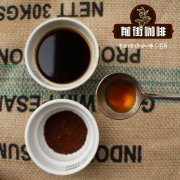Coffee roasting and Flavor Coffee Flavor and Baking relationship Coffee Baking Flavor Adjustment

Professional coffee knowledge exchange more coffee bean information please follow the coffee workshop (Wechat official account cafe_style)
The 700 or 800 aroma ingredients contained in raw coffee beans must be awakened by professional roasting. Without this baking procedure, coffee is just some uncomfortable taste of the sun or water, let alone as a drink. After five to seven minutes of strong heating, raw beans cause drastic chemical changes, which in turn give off a special strong fragrance, a complex chemical reaction that even the most sophisticated laboratory cannot simulate, but it can probably be summed up into a few key items.
First of all, after baking raw beans at more than 200 degrees Celsius, the moisture begins to evaporate, the volume expands by 60%, and the weight is reduced by about 20%. Depending on the degree of baking, the deeper the baking, the more weight loss. Another important phenomenon is exhaust. Raw beans release carbon dioxide coffeebyroast during roasting, and coffee beans continue to exhaust after roasting. Carbon dioxide emissions are conducive to the preservation of coffee beans, because in the process of exhaust, oxygen molecules are not easy to invade, that is, the oxidation that affects the freshness of coffee cannot be carried out, but the exhaust gradually slows down after baking. Oxygen molecules are easily attached to the surface of coffee beans, and coffee will soon lose its flavor, which is an important reason why it is best to drink coffee beans as much as possible after opening the seal.
The secret of coffee roasting
The chemical reaction of coffee beans can be judged by sound, color and taste when roasting. As the color of coffee beans continues to heat up, the color of coffee beans will change from grayish green to golden brown to light brown, followed by a small amount of oil showing a dark brown of oil. if you continue to bake, the oil on the surface of coffee beans will dry and appear black. and emit a lot of smoke, mixed with scorching smell, this is a warning close to the ignition point, coffee beans from light to dark, due to changes in caramelization and acidic substances.
Listening to sound is also the basis for judging the degree of baking. If the temperature of the roaster is hot enough, coffee beans will burst twice in the roasting process. For example, heat-resistant raw beans such as Mantenin and Antigua will give off the first explosion in about seven minutes, and the sound will be low and sparse. This means that the pyrolysis has been started, that is, the starch begins to be converted into caramel, and the water also spurts out of the bean table with carbon dioxide, making a low burst sound, which is quiet for two minutes. The second explosion was sent out at about 12 minutes, which means that the coffee beans have almost been roasted, and then the coffee beans are removed from the roaster to the cooling plate, and the aroma is immediately filled with aroma!
Other factors affecting coffee roasting
The hardness, water content and year of raw coffee beans all affect roasting, so roasters will adjust the roasting treatment of coffee because of this influence factor. Generally speaking, the newer the beans, the higher the water content, and the dehydration time should be increased during baking. On the other hand, the raw beans with more years have lower moisture and acidity, the time of dehydration should be shorter, and under the same baking conditions, the acidity of raw beans will be weaker and softer than that of new beans.
Important Notice :
前街咖啡 FrontStreet Coffee has moved to new addredd:
FrontStreet Coffee Address: 315,Donghua East Road,GuangZhou
Tel:020 38364473
- Prev

Water absorption of deep-roasted coffee beans and light-roasted coffee beans
Professional coffee knowledge exchange more coffee bean information please follow the coffee workshop (Wechat official account cafe_style) 1. Shallow baking: shallow baked beans usually swell and bubble when they encounter hot water. This is not because they are not fresh, but because the texture of shallow baked beans is relatively tight, and the beans that dare to bake shallowly are high-grade high-quality beans.
- Next

Coffee roasting and Flavor [II] Coffee roasting Coffee Flavor Light Coffee lack of Baking Flavor
Professional coffee knowledge exchange more coffee bean information please pay attention to coffee workshop (Wechat official account cafe_style) Coffee roasting to put it simply is to roast raw beans, cooked and roasted thoroughly, the definition will vary according to everyone's subjective preferences. So the final roasted coffee beans will have a lot of unpredictable disadvantages. And the common bitterness and astringency in baking or
Related
- Beginners will see the "Coffee pull flower" guide!
- What is the difference between ice blog purified milk and ordinary milk coffee?
- Why is the Philippines the largest producer of crops in Liberia?
- For coffee extraction, should the fine powder be retained?
- How does extracted espresso fill pressed powder? How much strength does it take to press the powder?
- How to make jasmine cold extract coffee? Is the jasmine + latte good?
- Will this little toy really make the coffee taste better? How does Lily Drip affect coffee extraction?
- Will the action of slapping the filter cup also affect coffee extraction?
- What's the difference between powder-to-water ratio and powder-to-liquid ratio?
- What is the Ethiopian local species? What does it have to do with Heirloom native species?

